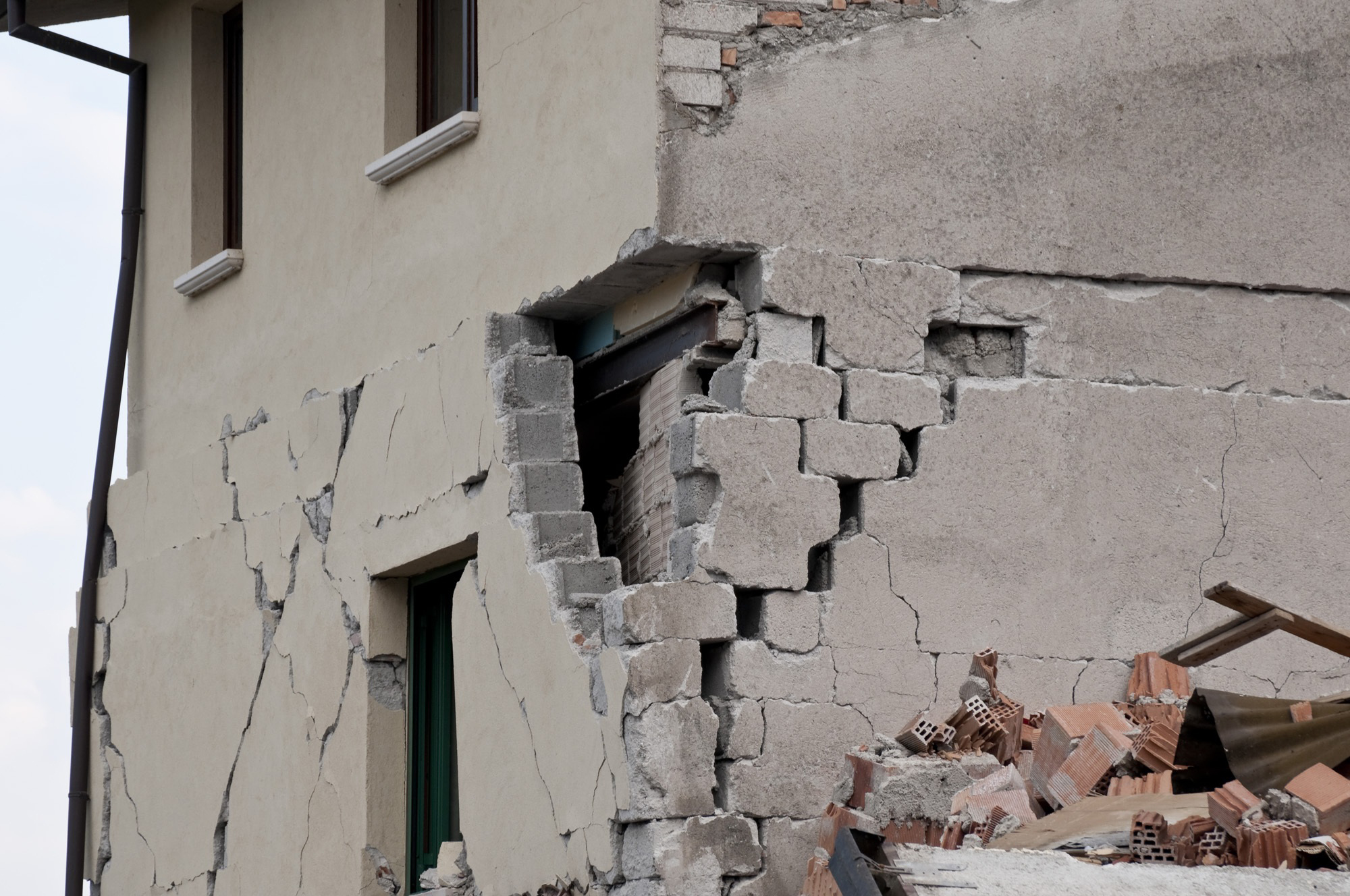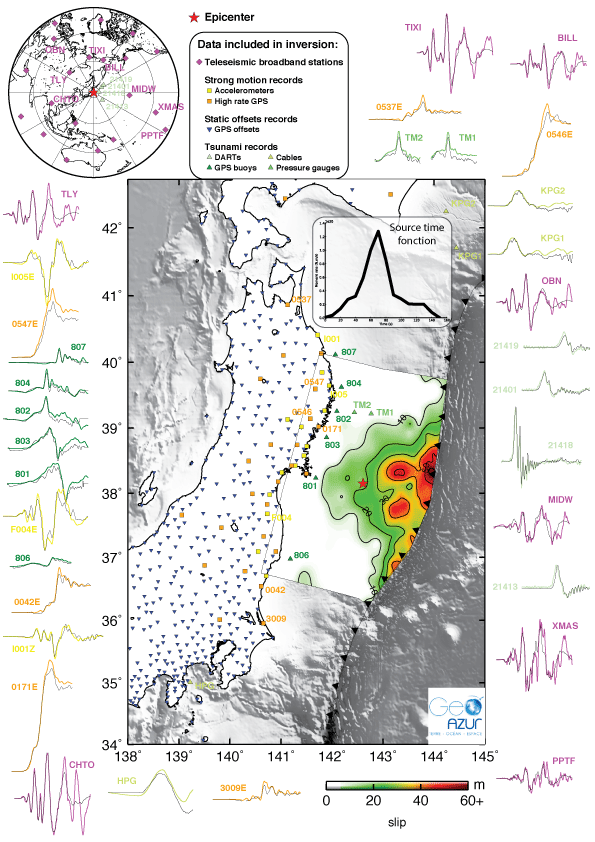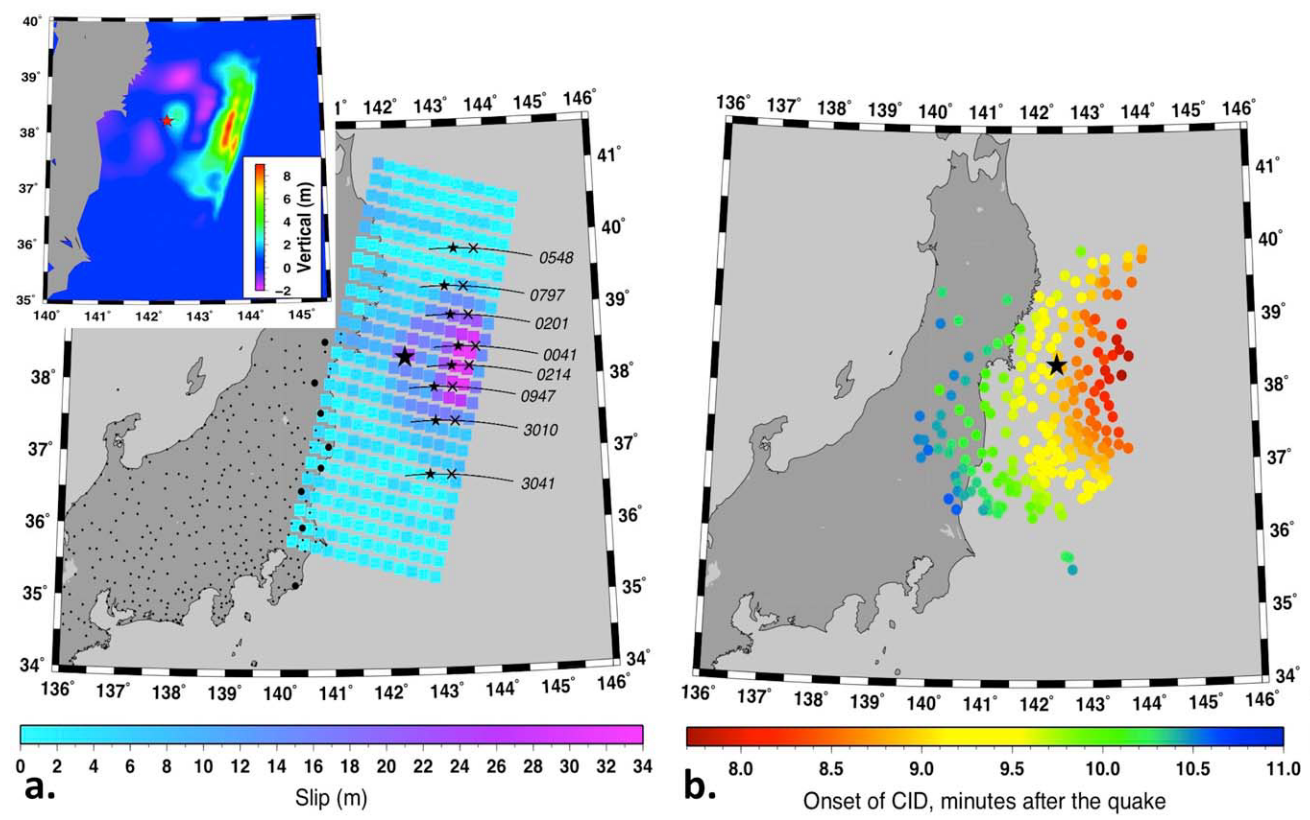
A critical case-study to improve earthquake and tsunami anticipation
A fundamental question raised by the Tohoku-Oki earthquake is to know whether seismic rupture of giant earthquakes can be anticipated either in time (months, days or hours before the rupture), location and/or magnitude, and how, within 10 minutes after the quake, the amplitude of a tsunami can be estimated before it reaches the coast. Over the last decades, scientists have tried to address this question through different approaches, but mainly by (1) trying to isolate potential precursory signals or (2) improving our knowledge of the seismic cycle (how stress and strain balance over several earthquakes) to understand the physical parameters that control the size and location of those large earthquakes. More recently, a third more practical approach was developed called (3) early-warning which takes advantage of the slower propagation speed of seismic or tsunami waves compared to our communication networks to provide at least a few seconds or minutes to anticipate the approaching waves and gauge the threat they represent.
In 2011, we initiated a project which acknowledges all these different approaches to bring new perspectives on earthquake anticipation based on the unique data set of the Tohoku-Oki earthquake. The project was mainly organized into three topics:
• the study of the seismic cycle: detailed modeling of the whole seismic sequence of the Tohoku-oki earthquake, including pre-, co- and post-seismic phases to study their interplay and respective contribution to the seismic cycle;
• investigation of new early-warning methods through the analysis of the atmospheric and ionospheric perturbations related to the earthquake rupture and the tsunami propagation. Investigate the feasibility of to use this approach for early-warning purpose and improve the estimation of the tsunami amplitude at the source;
• the analysis of pre-earthquake signals: critical analysis and modeling of the possible slow-slip events prior the Tohoku-oki earthquake.
This project was funded by a joint flash program between the ANR (France) and JST (Japan) agencies, for a 18-month period following the Japan earthquake (2011-2013). It initiated a broad collaboration and led to many significant results. A recent one was the identification of a generic link between the geometry of subduction zones and the location of mega-earthquakes (Bletery et al., Science, 2016).
***
TO-EOS - The Tohoku-Oki Earthquake from Earth to Oceans and Space
PRINCIPAL INVESTIGATOR: A. Sladen (Geoazur, France)
PARTNERS - France: IPG Paris, ENSG (IGN), CEA - Japan: ERI Tokyo, GSI
BEGINNING on October 2011
DURATION 18 months
FUNDING from the ANR (France) and JST (Japan) agencies
***
|
Fig. 1: Imagery of the fault slip amplitude of the Mw9.0 2011 Tohoku-Oki earthquake, Japan. Around the figure are shown a sample of the various data used to image the rupture process: near- and far-field seismology, GPS and tsunami data. From Bletery et al. (2014). |
Fig. 2: Comparison of a sea-bottom deformation estimated for the Tohoku-Oki earthquake (left) and of the ionosphere perturbation imaged by satellite GPS PRN26 (right). The former is an indirect estimate and is not available right after the earthquake. On the other hand, the ionosphere perturbations can be imaged within a few minutes after an earthquake and therefore contribute to tsunami early-warning. From Astafyeva et al. (2011).
Fig. 3: When a subduction plate is flat (left), the rupture threshold is reached simultaneously over the whole zone, which can start mega-earthquakes. On the contrary, when the subduction plate is highly curved, the threshold is more heterogeneous, leading to more frequent, but more moderate, earthquakes. From Bletery et al. (2016). |
***
Publications related to the project
- Astafyeva, E. P. Lognonne, L. Rolland (2011). First ionosphere images for the seismic slip of the Tohoku-oki earthquake. Geophys. Res. Lett., 2011, V.38, L22104, DOI:10.1029/2011GL049623.
- Astafyeva, E., Rolland, L., Lognonné, P., Khelfi, K., & Yahagi, T. (2013). Parameters of seismic source as deduced from 1 Hz ionospheric GPS data: case study of the 2011 Tohoku‐oki event. Journal of Geophysical Research: Space Physics, 118(9), 5942-5950.
- Astafyeva, E., Shalimov, S., Olshanskaya, E., Lognonné, P. Ionospheric response to earthquakes of different magnitudes: larger quakes perturb the ionosphere stronger and longer. Geophys. Res. Lett., 40, 1675–1681, doi:10.1002/grl.50398.
- Astafyeva, E., Rolland, L. M., & Sladen, A. (2014). Strike-slip earthquakes can also be detected in the ionosphere. Earth and Planetary Science Letters, 405, 180-193.
- Bletery, Q., Sladen, A., Delouis, B., Vallée, M., Nocquet, J. M., Rolland, L., & Jiang, J. (2014). A detailed source model for the Mw9. 0 Tohoku‐Oki earthquake reconciling geodesy, seismology, and tsunami records. Journal of Geophysical Research: Solid Earth, 119(10), 7636-7653.
- Bletery, Q., Sladen, A., Delouis, B., & Mattéo, L. (2015). Quantification of tsunami bathymetry effect on finite fault slip inversion. Pure and Applied Geophysics, 172(12), 3655-3670.
- Bletery, Q., Sladen, A., Jiang, J., & Simons, M. (2016). A Bayesian source model for the 2004 great Sumatra‐Andaman earthquake. Journal of Geophysical Research: Solid Earth, 121(7), 5116-5135.
- Bletery, Q., Thomas, A. M., Rempel, A. W., Karlstrom, L., Sladen, A., & De Barros, L. (2016). Mega-earthquakes rupture flat megathrusts. Science, 354(6315), 1027-1031.
- Coïsson, P., Lognonné, P., Walwer, D., & Rolland, L. M. (2015). First tsunami gravity wave detection in ionospheric radio occultation data. Earth and Space Science, 2(5), 125-133.
- Kherani, E. A., Lognonné, P., Hébert, H., Rolland, L., Astafyeva, E., Occhipinti, G., ... & de Paula, E. R. (2012). Modelling of the total electronic content and magnetic field anomalies generated by the 2011 Tohoku‐Oki tsunami and associated acoustic‐gravity waves. Geophys. J. Inter., 191(3), 1049-1066.
- Kherani, E. A., Rolland, L., Lognonne, P., Sladen, A., Klausner, V., & De Paula, E. R. (2016). Traveling ionospheric disturbances propagating ahead of the Tohoku-Oki tsunami: a case study. Geophysical Journal International, 204(2), 1148-1158.
- Occhipinti G., Rolland L., Lognonné P. and Watada, S. From Sumatra 2004 to Tohoku-Oki 2011: the systematic GPS detection of the ionospheric signature induced by tsunamigenic earthquakes, J. Geophys. Res., 10.1002/jgra.50322, in press.
- Rolland L., Vergnolle, M., Nocquet, J.-M., Sladen, A., Dessa, J.-X., Tavakoli, F., Nankali, H. F. and Cappa, F., Discriminating the tectonic and non-tectonic parts in the ionospheric signature of the 2011, Mw=7.1, dip-slip Van earthquake, Eastern Turkey, Geophys. Res. Lett., 40, 2518–2522, doi:10.1002/grl.50544.







